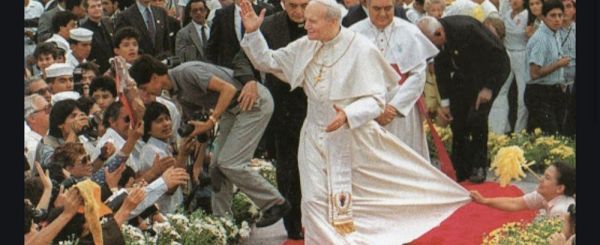1. "Pueri Hebraeorum, portantes ramos olivarum.... The Jewish children went to meet the Lord waving olive branches".
This is the antiphon that we sing in the solemn procession as we carry our branches of olive and palm on this Sunday, called Palm or Passion Sunday. We have relived what took place on that day: in the midst of the crowd rejoicing around Jesus who entered Jerusalem riding a donkey there were crowds of children. Some Pharisees would have wanted Jesus to have them keep quiet, but he answered that if they would have been silent, even the stones would have cried out (cf. Lk 19,39-40).
Even today, thanks be to God, there is a multitude of young people here in St Peter's Square. The "children of Jerusalem" have become young men and women of every nation, language and culture. Welcome, dear friends! I warmly greet each one of you! Today's gathering directs us toward the coming World Youth Day, that will take place in Toronto, Canada, one of the most cosmopolitan cities in the world. The World Youth Day Cross is already there. Last year on Palm Sunday, Italian young people entrusted it to their Canadian peers.
2. The Cross is the focus of the liturgy today. Dear young people, with your attentive and enthusiastic participation in this solemn celebration, you show that you are not ashamed of the Cross. You do not fear the Cross of Christ. Indeed, you love and venerate it because it is the sign of the Redeemer who died and rose again for us. Those who believe in Jesus, crucified and risen, carry the Cross in triumph as an indisputable proof that God is love. With the total gift of himself on the Cross, our Saviour decisively conquered sin and death. Therefore we joyfully proclaim: "Glory and praise to you, O Christ who has redeemed the world with your Cross".
3. "Christ became obedient for us even to death, death on the Cross. Therefore God raised him on high and gave him a name above every other name" (Gospel acclamation).
We have used these words of the Apostle Paul, just heard in the Second Reading, as our acclamation before we begin the reading of the Passion. They express our faith: the faith of the Church.
However, faith in Christ can never be taken for granted. The reading of his Passion sets us before Christ, living in his Church. The Easter Mystery that we will relive during the days of Holy Week is always present. Today we are contemporaries of the Lord and, like the multitude in Jerusalem, like the disciples and the women, we are called to decide if we are to be with him, or flee, or just be spectators at his death.
Every year in Holy Week the curtain rises once again on the great scene in which the definitive drama is decided, not only for one generation, but for all humanity and for each one.
4. The Passion narrative points out the fidelity of Christ, contrasted with human infidelity. In the hour of his trial, while the disciples and even Peter abandon Jesus (cf. Mt 26,56), He remains faithful, willing to pour out his blood to bring to fulfilment the mission the Father has entrusted to him. Beside him is Mary, silent and suffering.
Dear young people! Learn from Jesus and from his and our Mother. The real strength of a man lies in the fidelity of his witness to the truth and in his resisting flattery, threats, misunderstandings, blackmail, even harsh and relentless persecution. This is the path on which our Redeemer calls us to follow him.
Only if you are ready to do this, will you become what Jesus expects of you, that is, "the salt of the earth" and "the light of the world" (Mt 5,13-14). As you know, this is the theme for the coming World Youth Day. The image of salt "reminds us that, through Baptism, our whole being has been profoundly changed, because it has been "seasoned' with the new life which comes from Christ (cf. Rom 6,4)" (Message for the 17th World Youth Day, n. 2).
Dear young people, do not lose your flavour as Christians, the flavour of the Gospel! Keep it alive by meditating constantly on the Easter Mystery: may the Cross be your school of wisdom. Boast of nothing else save this sublime throne of truth and love.
5. The liturgy invites us to climb towards Jerusalem with Jesus, hailed by the young Jews. In a little while he "will have to suffer and on the third day rise from the dead" (Lk 24,46). St Paul has reminded us that Jesus "emptied himself, taking the form of a servant" (Phil 2,7) to obtain for us the grace of divine sonship. From him springs the true spring of peace and joy for each one of us! Here is the secret of the Easter joy that is born from the hardship of the Passion.
I hope that each one of you will share in this joy, dear young friends. The One you have chosen as Teacher is not a merchant of deceptions, not a powerful one of this world, not a ready and skilled debater. You know who it is you have chosen to follow: the Crucified is risen! The Crucified is risen! Christ died for you, Christ rose for you.
The Church assures you that you will not be disillusioned. Indeed, no one else other than he can give you that love, peace, and eternal life for which your heart so deeply yearns. Blessed are you young people if you will be faithful disciples of Christ! Blessed are you who are ready to witness on every occasion that this man is truly the Son of God (cf. Mt 27,39).
May Mary, Mother of the incarnate Word guide and go with you, ready to intercede for everyone who comes into the world.
[Pope John Paul II, Palm Sunday homily 24 March 2002]












